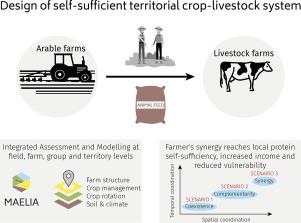Agricultural Systems ( IF 6.1 ) Pub Date : 2021-01-22 , DOI: 10.1016/j.agsy.2021.103066 Rui Catarino , Olivier Therond , Jérémy Berthomier , Maurice Miara , Emmanuel Mérot , Renaud Misslin , Paul Vanhove , Jean Villerd , Frédérique Angevin

|
CONTEXT
Crop diversification is now well-recognised as a strong lever to address the environmental challenges currently faced by agriculture. Connecting and fostering local exchanges between specialised arable crop and livestock farms can support the diversification of crops and relocate animal feeding with local protein (vs. soya supplements). However, the trade-offs and synergies between individual and collective objectives and performances generated by this system are still largely unknown. Innovative tools that consider the spatiotemporal heterogeneity underpinning the daily functioning of farms are needed to explore the implications of exchange scenarios.
OBJECTIVES
To assess self-sufficiency, sustainability and vulnerability at the farm, group (arable vs. livestock) and territorial levels considering the baseline situation and scenarios that increase synergy between arable and livestock farms.
METHODS
We demonstrated the utility of using MAELIA, a spatial agent-based integrated modelling framework, to support iterative design and assessment of self-sufficiency, sustainability and vulnerability of such scenarios. MAELIA was applied to model a collective of five arable and two livestock farmers in western France. In a participatory approach, scientists, agricultural advisers and the farmers co-designed three possible scenarios of legume exchanges.
RESULTS AND CONCLUSIONS
Only the most ambitious scenario based on strong collaboration allowed farmers to reach local protein self-sufficiency while reducing the variability in five of the seven indicators used to assess farm performances. Meeting livestock farms' demand for legumes had a positive influence on socio-economic performance at the territorial level, including an increase in the mean gross margin (of 71 €/ha; 4% higher), decrease in the use of nitrogen fertiliser (of ca. 21 kg N/ha; 11% lower) and decrease in labour time (of ca. 12 min/ha; 5% lower). No major trade-offs between self-sufficiency and vulnerability were observed. However, there were distinct individual performances related to the degree of changes imposed on each farm.
SIGNIFICANCE
We show that by reducing the dependence to external inputs, these systems are promising alternatives to an environmentally sustainable, resilient and economically viable agroecological transition. The development of dedicated institutional support for direct bilateral or multilateral agreements, and specific financial and technical support would encourage farmers to join such initiatives and redesign their farming systems.
中文翻译:

使用基于MAELIA平台的创新性综合评估和建模方法,通过豆类交易促进当地农作物-畜牧业整合
语境
如今,农作物多样化已被公认为应对当前农业面临的环境挑战的有力手段。连接和促进专用耕作农作物与畜牧场之间的本地交流可以支持农作物的多样化,并用当地蛋白(相对于大豆补充剂)来迁移动物饲料。但是,该系统所产生的个人和集体目标与绩效之间的取舍和协同作用仍然未知。需要采用创新工具来考虑时空异质性,这些异质性是农场日常运作的基础,以探讨交换情景的影响。
目标
为了评估农场,群体(耕种对畜牧业)和地区一级的自给自足,可持续性和脆弱性,并考虑基线状况和情景,以增加耕种和畜牧场之间的协同作用。
方法
我们演示了使用MAELIA(基于空间代理的集成建模框架)来支持迭代设计和评估此类方案的自给性,可持续性和脆弱性的实用性。使用MAELIA对法国西部的五个耕种农民和两个牲畜养殖户进行了建模。以参与方式,科学家,农业顾问和农民共同设计了三种可能的豆类交易方案。
结果与结论
只有基于强有力合作的最雄心勃勃的方案,才能使农民实现地方蛋白质的自给自足,同时减少用于评估农场绩效的七个指标中五个指标的差异。满足牧场对豆类的需求对领土一级的社会经济绩效产生了积极影响,包括平均毛利率增加(71欧元/公顷;增加4%),氮肥使用减少(约21千克N / ha;降低11%)并减少劳动时间(约12分钟/公顷;降低5%)。在自给自足和脆弱性之间未观察到重大的取舍。但是,有不同的个人表现与每个农场的变化程度有关。
意义
我们表明,通过减少对外部投入的依赖,这些系统有望成为环境可持续,弹性和经济上可行的农业生态转型的替代方案。为直接的双边或多边协定发展专门的机构支持,以及提供具体的财政和技术支持,将鼓励农民加入此类倡议并重新设计其耕作制度。











































 京公网安备 11010802027423号
京公网安备 11010802027423号